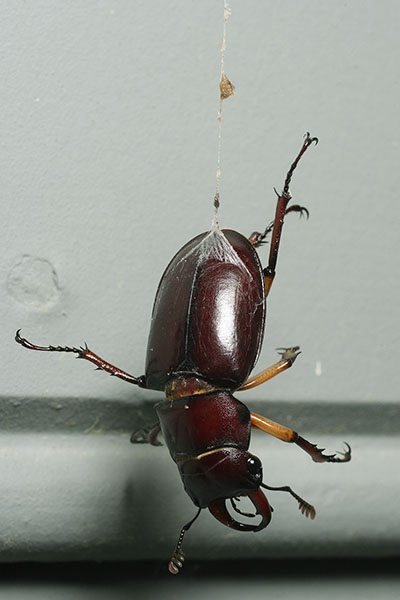 Out the other night in the yard looking for photo subjects, I found a curious bit of drama. A female reddish brown stag beetle (that’s the actual common name, scientifically named Lucanus capreolus) had gotten herself caught in a corner web and was dangling, unable to get a foothold on anything to draw herself free. Stag beetles are among the largest US beetles, certainly the most impressive in NC, this one running 35-40 mm I believe. A few days earlier I had handled one that was perched on our porch screens, attracted by the light at night – don’t pin them down and you won’t get acquainted with those lovely pincers. If you let them walk on your hand, however, those climbing hooks on their feet are hard to avoid, and she managed to get one of her feet hooked fast into my finger and couldn’t extricate herself for a minute – this isn’t exactly painful, but it’s noticeable, and you’re quite aware something is wrong. You’re also aware that grabbing it to help it get free is possibly not the best move. It is entirely possible that the one getting caught on my finger and the one seen here are the same individual; they were found only a few meters apart, a few days apart. You can’t blame it on the light attracting the beetle towards danger, however, because this is probably the darkest corner of the property, day or night, and I found this tableau by flashlight myself.
Out the other night in the yard looking for photo subjects, I found a curious bit of drama. A female reddish brown stag beetle (that’s the actual common name, scientifically named Lucanus capreolus) had gotten herself caught in a corner web and was dangling, unable to get a foothold on anything to draw herself free. Stag beetles are among the largest US beetles, certainly the most impressive in NC, this one running 35-40 mm I believe. A few days earlier I had handled one that was perched on our porch screens, attracted by the light at night – don’t pin them down and you won’t get acquainted with those lovely pincers. If you let them walk on your hand, however, those climbing hooks on their feet are hard to avoid, and she managed to get one of her feet hooked fast into my finger and couldn’t extricate herself for a minute – this isn’t exactly painful, but it’s noticeable, and you’re quite aware something is wrong. You’re also aware that grabbing it to help it get free is possibly not the best move. It is entirely possible that the one getting caught on my finger and the one seen here are the same individual; they were found only a few meters apart, a few days apart. You can’t blame it on the light attracting the beetle towards danger, however, because this is probably the darkest corner of the property, day or night, and I found this tableau by flashlight myself.
The owner of the web, probably a common house spider (Parasteatoda tepidariorum) so often found in dark corners, was making a valiant attempt to subdue the beetle, even though the size disparity was comical.
 The beetle wasn’t in the mood to be cooperative, so the spider seemed able or confident only in dealing with the extremities; the effectiveness of this was pretty much as you imagine. In fact, the spider probably needed to sharpen her fangs after the attempts.
The beetle wasn’t in the mood to be cooperative, so the spider seemed able or confident only in dealing with the extremities; the effectiveness of this was pretty much as you imagine. In fact, the spider probably needed to sharpen her fangs after the attempts.
I was reminded irresistibly of going to a restaurant with a young child and allowing them to order for the first time – the conversation invariably involves something like, “Are you sure you can eat all that?” The answer is always yes; the result is no. I suppose when you have eight eyes that are all bigger than your belly, the effect is magnified.
Another interesting perspective was in evidence as well, since there was a male house spider in the web at the time, which means he was in the process of wooing the female. I know what you’re thinking, but no, the beetle was not a present from an overeager suitor, since the male spider was less than half the size of the female. He was also, chivalry be damned, not doing anything at all to assist her in subduing her statuesque meal. If emotions of any kind can be ascribed to spiders, beyond basic lust I mean, it would have been frustration over having to wait while she tried to figure out what to do about the beetle. There are all sorts of distasteful jokes that I’m avoiding right now, and if you’ve read the slug porn post, you know that this is saying something.
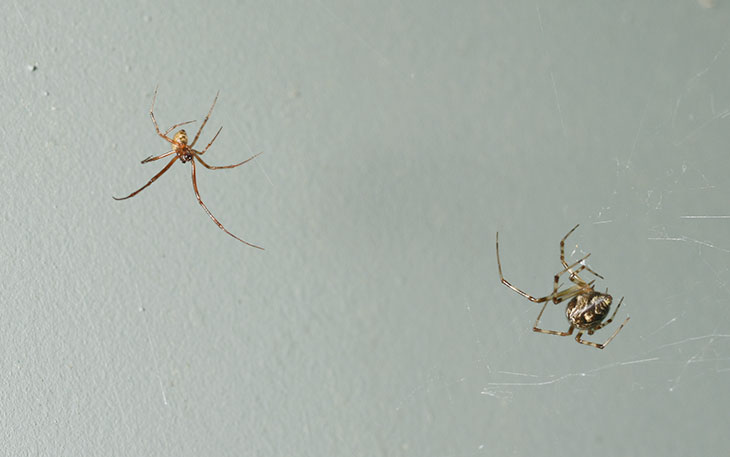
The next morning, the beetle was still there and still very much alive, not enveloped in webbing or anything, so I detached it from the web and set it free. The spider was given fair chance, but I saw no point in letting the beetle die from dehydration over a chance event. There are all sorts of ethical questions that can be asked about my actions, and have at it if you like; I don’t find it that important myself.
A few days before that, I’d also tackled another project that’s been in the back of my mind since we moved in. We have a raised porch, and the space underneath is a sheltered, bare earth area good for storing garden implements and such. While moving things in there, I spotted several telltale conical impressions that indicate ant lions, and resolved to do a photo set and post about them.
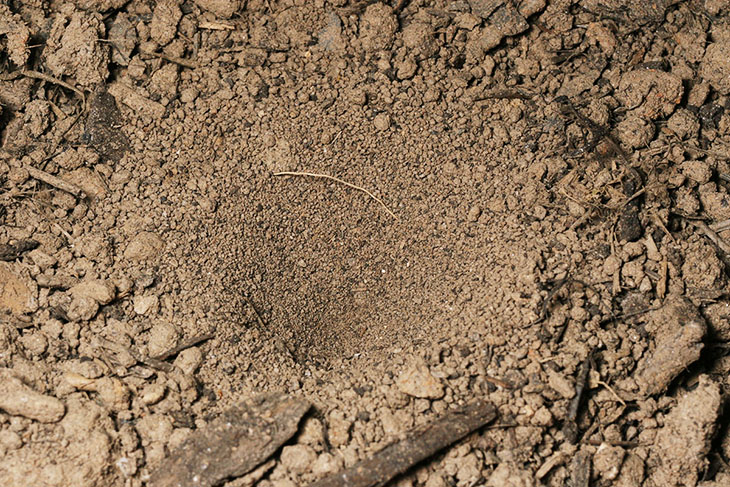
Unfortunately, the pits are rather hard to photograph, especially in deep shade where additional light is needed, so this isn’t perhaps illustrating it as well as I’d like. The pits are small, a few centimeters across at best, and perfectly conical; they are also distinctive in that the interiors are all very fine grit or sand, regardless of what the ground surface is like. They are often found sheltered from direct rain and wind. These are the traps of ant lions, actually the larva of a lacewing fly in the genus Myrmeleon. And the way it all operates is fascinating.
First off, the pits are created by the larva digging around just under the surface of loose soil or sand, moving in a circle and using their head to flip the soil out of the way, slowly digging a pit in this manner. The sides are steep and coated with loose material, so that any insect wandering into it will find itself on an unstable slope carrying it down to the bottom of the pit; this is, naturally, where the ant lion waits. Should the insect be capable enough to maintain a footing and possibly even fight upwards, it will get pelted by debris from the same head-flips of the Myrmeleon, likely dislodging it to slide to the bottom. Once in range, the ant lion pokes its formidable chelicerae out and envenoms the victim, making it sluggish and unable to resist within a minute or two. The Myrmeleon larva then draws it underneath the soil and drains it of nutrients, discarding the corpse a few days later.
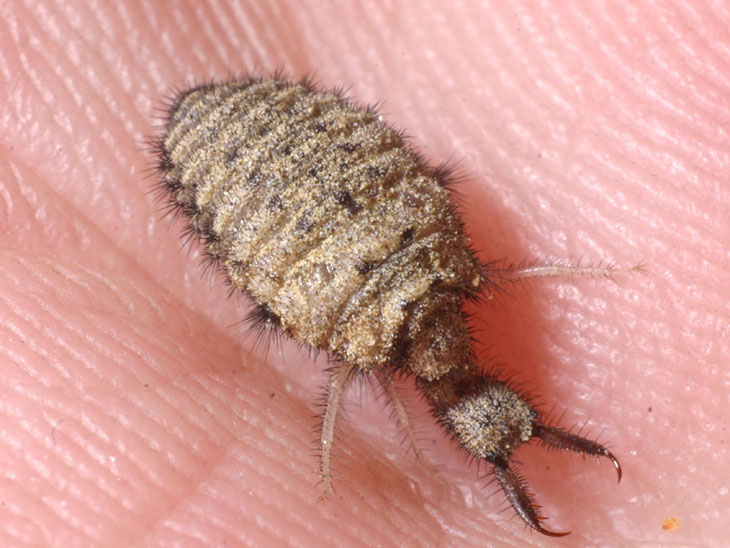
Here’s a sizable specimen that I unearthed a few years back; if I looked like that I’d stay buried too. They’re quite small, only a few millimeters in length, and harmless to humans. But what I was after was a capture. I waited patiently for some time crouched under the porch, but there were no potential victims to be seen in the area, so I went out looking for one. What I found was probably not the best choice.

This is an assassin bug larva, probably genus Pselliopus. It’s a little hard to make out, but let me build this a bit. Most times when you see insects with bright, contrasting colors, it’s a warning that they’re distasteful in some way; the coloration and some defensive mechanism work together to make the insect memorable to potential predators. So, the reason that you can’t make out the assassin bug too well is that its legs are largely coated with soil, which occurred soon after it reached the bottom of the pit after I dropped it in. Now I assumed, after examining the pics, that this was due to the defensive mechanism of the bug, some skin secretion that was bad-tasting or perhaps irritating, triggered by the attack of the ant lion. However, I can find no mention of this being a trait of the species.
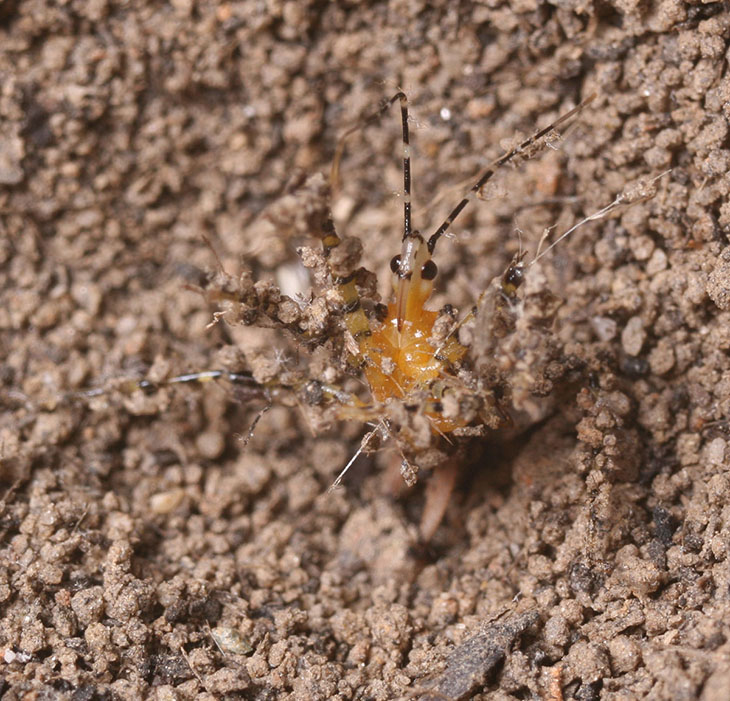
Nevertheless, the ant lion seemed to respond appropriately. While the assassin bug struggled feebly, seeming to have already been injected by the ant lion, the ant lion was attempting to fling the victim back out of the pit. If you look closely at the above image, the head and pincers, well out of focus, can be seen underneath the assassin bug – the chelicerae are slightly paler than the surrounding soil, even though the head is a perfect match. I watched for some time, but the ant lion wanted nothing to do with the assassin bug, and I eventually removed it from the pit.

Thereafter, the ant lion immediately set to work reconstructing the capture pit. Some larger bits of grit and soil had been dislodged, and instead of flipping these out of the way off the top of its head, it seized the ‘boulders’ in its pincers and hurled them away in that manner. Very often, these never cleared the pit rim and rolled right back down again to bounce off the ant lion’s head, and the performance would be repeated with stoic patience; I personally, after the third attempt, would have carried the offending fragment to the top of the pit and slammed it into position well out of the way, but that’s the difference between humans and arthropods. Whether this is a good or a bad thing should probably be judged by some other, neutral species.




















































